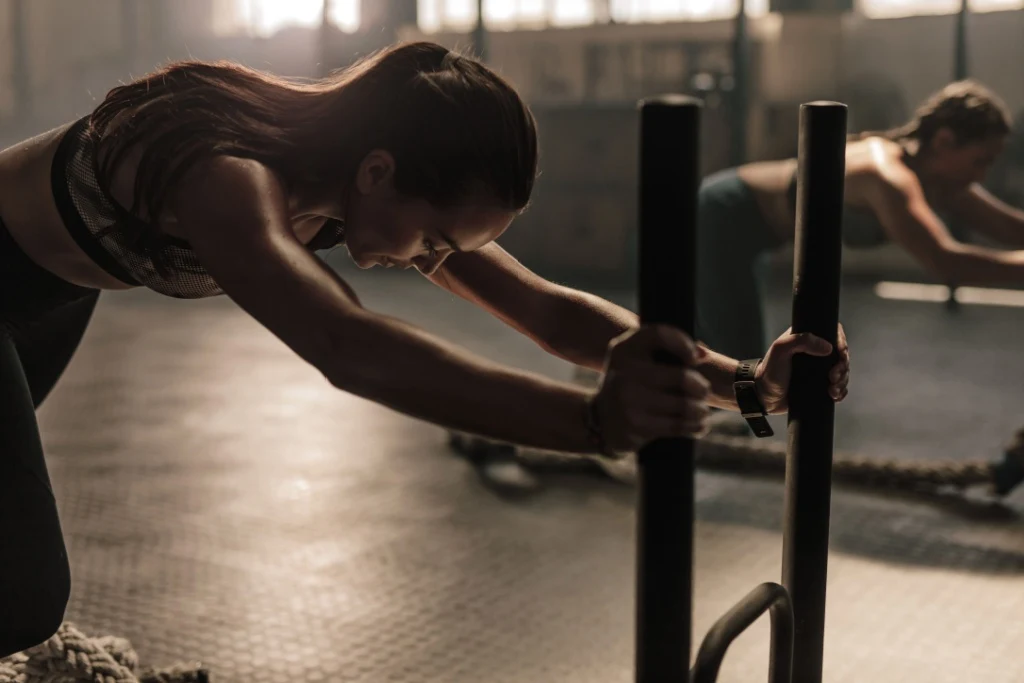Build Real-Life Strength With Functional Strength Training
Train smarter, not just harder. Functional strength training builds the kind of strength you’ll actually use every day.

November 3, 2022 - Updated September 18, 2025

Functional strength training has been a buzzword in the fitness world for years, but what does it actually mean, what’s so good about it and how is different from normal strength training?
What is functional strength training?
Simply put, it’s a training style that’s designed to prepare your body for all the movements you do in everyday life. Where a traditional strength training program like Strength with Kayla might have you using a barbell and gym machines, a functional workout routine like Thrive with Ruba involves a wider range of exercises that mimic how the body moves in real life.
Squatting down to pick up a heavy deadball is the perfect preparation to lift pets, children or boxes when moving house. Pressing weight overhead in the gym makes it easy to reach and grab things from the top shelf. Doing farmers carry walks with kettlebells makes carrying heavy groceries a breeze. Sandbag lunges make hiking with a heavy backpack feel like a walk in the park. Twisting movements help to build stability and spinal mobility to reduce your risk of injury when twisting in real life.
Unlike some traditional strength training exercises, which often isolate one muscle group (or even one specific muscle) at a time, functional strength exercises also generally use multiple muscles and joints together - more like how your body naturally moves.
Functional strength training exercises can use a range of equipment such as kettlebells, dumbbells, resistance bands, suspension trainers, barbells, or simply your bodyweight!
Benefits of functional strength training
Functional strength workouts can improve your:
Strength
Stability
Cardiovascular fitness
Coordination
Mobility
Overall athleticism
Confidence
According to Mayo Clinic, functional strength training is a great way to build full-body strength, control and power that can help to improve your quality of life by making everyday movements easier and reducing your risk of injury.
A 2021 systematic review of the effect of functional training on fitness among athletes also concluded it significantly impacts speed, muscular strength, power, balance, and agility.

Functional vs traditional strength training
Although both training styles are fantastic for your overall health and will improve your strength (go figure), they can differ significantly in terms of things like exercises, workout structure, equipment and goals. Which one is better for you really depends on your personal goals and preferences.
Goals: With functional strength training, the aim is to build strength that will directly improve how you move in everyday life. With traditional strength training, the goal is usually to increase muscular strength, mass and endurance.
Exercises: Traditional strength training can include compound movements that engage multiple major muscle groups, but often also has a focus on isolation exercises that target individual muscles like bicep curls. You’ll be doing the same exercises repeatedly to progress and build strength. Functional strength training exercises tend to be multi-muscle and multi-joint movements that mimic how the body moves in daily life. Traditional exercises often only move in one plane of movement (forward and back) whereas functional strength training can have you moving side to side and twisting, too.
Equipment: Traditional strength training usually includes a mix of gym machines and free weights like barbells and dumbbells, whereas functional strength training can make the gym feel like a playground, using things like
resistance bands, kettlebells, sleds and medicine balls.
Workout structure: In a traditional strength workout, you’ll be doing repeated sets of one exercise (or two in a
superset) before moving on to the next. In a functional strength workout, you may find more variety with sets, supersets, pyramids or a circuit to challenge your body in different ways.
Progression: Making progress with traditional strength training is simple - you feel yourself getting stronger and add more weight. Functional strength training is the same, but you’re also working on improving your overall movement patterns. As well as feeling stronger, you might find yourself feeling more coordinated, balanced, agile, fit and ready to take on more advanced exercises.
It’s never too late to start
Whether you’re just starting out on your fitness journey, you lead an active lifestyle but haven’t tried strength training, or you feel like it’s too late to try something new, don’t let functional strength training intimidate you! It’s an incredible way to train no matter what fitness level you’re at, as you can start with bodyweight exercises in the comfort of your own home, or explore an entire gym’s worth of equipment if you already feel at home in the gym.
If you’re new to working out or have pre-existing injuries or health conditions, we always recommend checking with your healthcare professional before starting a new program or trying a different training style.
A well-designed workout program should make you feel stronger, fitter, and more confident, but it should also make daily movements much easier. That’s the power of functional strength training. Challenge yourself, improve your skills and athletic performance, move easier each day, and most importantly, feel great.

A more empowered you starts with Sweat, and our editorial team is here to bring you the latest fitness tips, trainer recommendations, wellbeing news, nutritional advice, nourishing recipes and free workouts.
* Disclaimer: This blog post is not intended to replace the advice of a medical professional. The above information should not be used to diagnose, treat, or prevent any disease or medical condition. Please consult your doctor before making any changes to your diet, sleep methods, daily activity, or fitness routine. Sweat assumes no responsibility for any personal injury or damage sustained by any recommendations, opinions, or advice given in this article.
Fitness